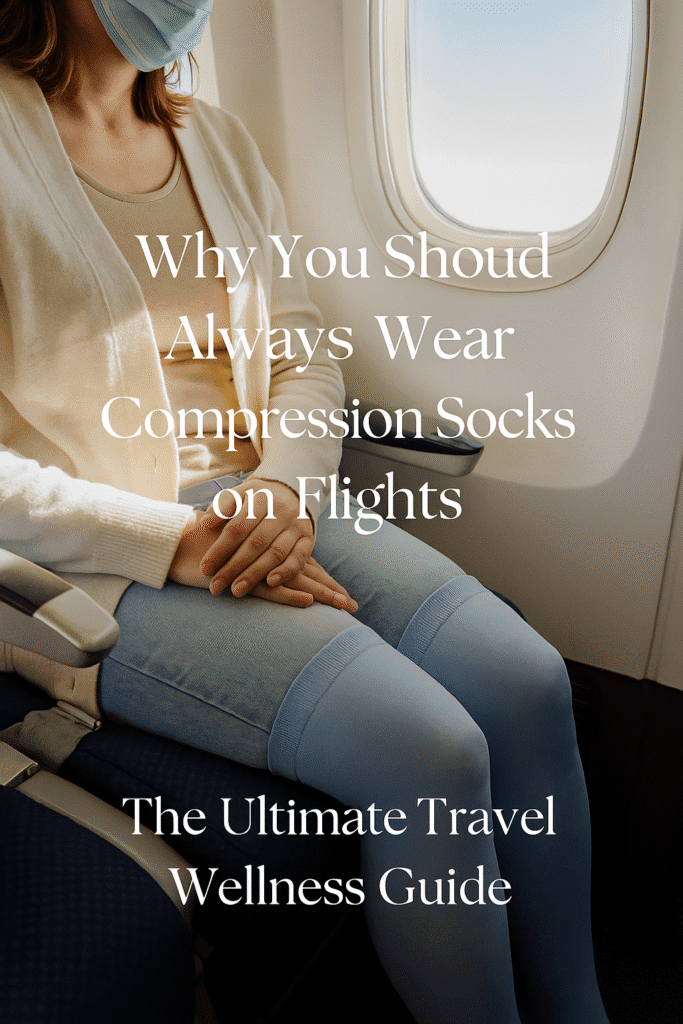Traveling by air can be an exciting adventure, whether you’re jetting off for a vacation, a business trip, or to visit loved ones. But spending hours in the tight quarters of an airplane seat does more than just make you antsy—it can take a real toll on your body, especially your legs and feet. That’s why frequent flyers, health experts, and travel bloggers alike recommend wearing compression socks on flights. In this travel blog guide, we’ll dive into the science, real-life benefits, and practical tips for staying healthy and comfortable in the skies.
The Problem: Why Do Legs and Feet Suffer During Flights?
When you fly, you’re often seated for long periods with limited space to stretch or move around. Gravity, cabin pressure, and inactivity slow your circulation, increasing the risk of swelling (edema), aching legs, and, more seriously, deep vein thrombosis (DVT)—a dangerous blood clot that can develop in your legs. Whether you’re on a short domestic hop or a 14-hour international journey, you’ve probably noticed your shoes feeling tighter post-flight or a numb, heavy sensation in your feet.
What Are Compression Socks—and How Do They Help?
Compression socks are specially designed garments that apply gentle, graduated pressure to your ankles and calves. The idea is simple but powerful: by squeezing the legs, these socks help veins move blood more efficiently upwards, preventing fluid from pooling and protecting your leg health.
Science-Backed Benefits of Compression Socks on Flights
Reduce swelling and discomfort: Compression prevents fluids from gathering in your lower legs—no more balloon feet after landing.
Lower the risk of blood clots (DVT): Medical experts strongly advise wearing compression socks on longer flights, especially for travelers with other risk factors.
Fight fatigue and aches: Better blood flow means less muscle soreness and a quicker bounce-back once you reach your destination.
Improve travel comfort: Compression socks add support, prevent throbbing, and simply make flying more pleasant for most travelers.

Who Should Wear Compression Socks on a Plane?
The answer: pretty much everyone can benefit, especially if you:
- Fly long distances (4+ hours)
- Have a history of circulatory issues, varicose veins, or DVT
- Are pregnant or recently had surgery
- Are older, overweight, or simply want to avoid swelling and pain
- Travel for work and want to arrive refreshed and ready to go
- Even healthy, younger travelers have noticed a major improvement in comfort by making compression socks part of their travel ritual.
How to Choose the Best Compression Socks for Flying
Compression Level: For travel, most experts recommend socks in the 15–20 mmHg range. For higher-risk flyers or those with medical conditions, 20–30 mmHg may be suitable, with doctor guidance.
Fit & Comfort: Socks should feel snug but not painfully tight. Use accurate sizing charts and measure your calf for best results.
Material: Look for moisture-wicking, breathable fabrics so your legs stay cool and comfy even in warm cabins.
Style: Compression socks now come in a host of colors and patterns—choose pairs that match your travel style or wardrobe!
Smart Tips for Air Travelers
Put them on before you leave for the airport—not mid-flight—so your legs start out fresh.
Stay hydrated: Drink plenty of water and avoid excess caffeine or alcohol, which can worsen swelling.
Stand up and move when possible: Walk the aisle or do simple calf raises and ankle circles at your seat.
Take them off after arrival: Give your legs a break and let your skin breathe once you’ve reached your destination.
Traveler Experiences: Real Relief in the Real World
Seasoned travelers swear by the difference. From business professionals landing ready for meetings to retirees exploring the world in comfort, compression socks are a tiny investment yielding massive payoffs—less swelling, more energy, and reduced risk of post-flight pain or complications.
Airlines and doctors alike recommend them; many even sell compression socks in airport boutiques! If you want to avoid puffy ankles, fatigue, or health headaches after landing, these socks are the secret weapon that fits in any suitcase.
Conclusion: Make Compression Socks a Non-Negotiable Part of Your Packing List
Don’t wait for discomfort or health scares to convince you. Make compression socks a regular part of your travel packing checklist, just like your passport, headphones, and phone charger. Whether you fly for work or fun, the small effort of pulling on a pair could mean the difference between spending your first day exploring or recovering.
Give your legs—and your overall health—the support they need. Your next journey should be about enjoyment, not aches and risk. Experience the positive change for yourself the next time you take to the skies.
Ready for takeoff? Slip on quality compression socks and enjoy every mile, every destination, and every adventure—pain-free and energized!
